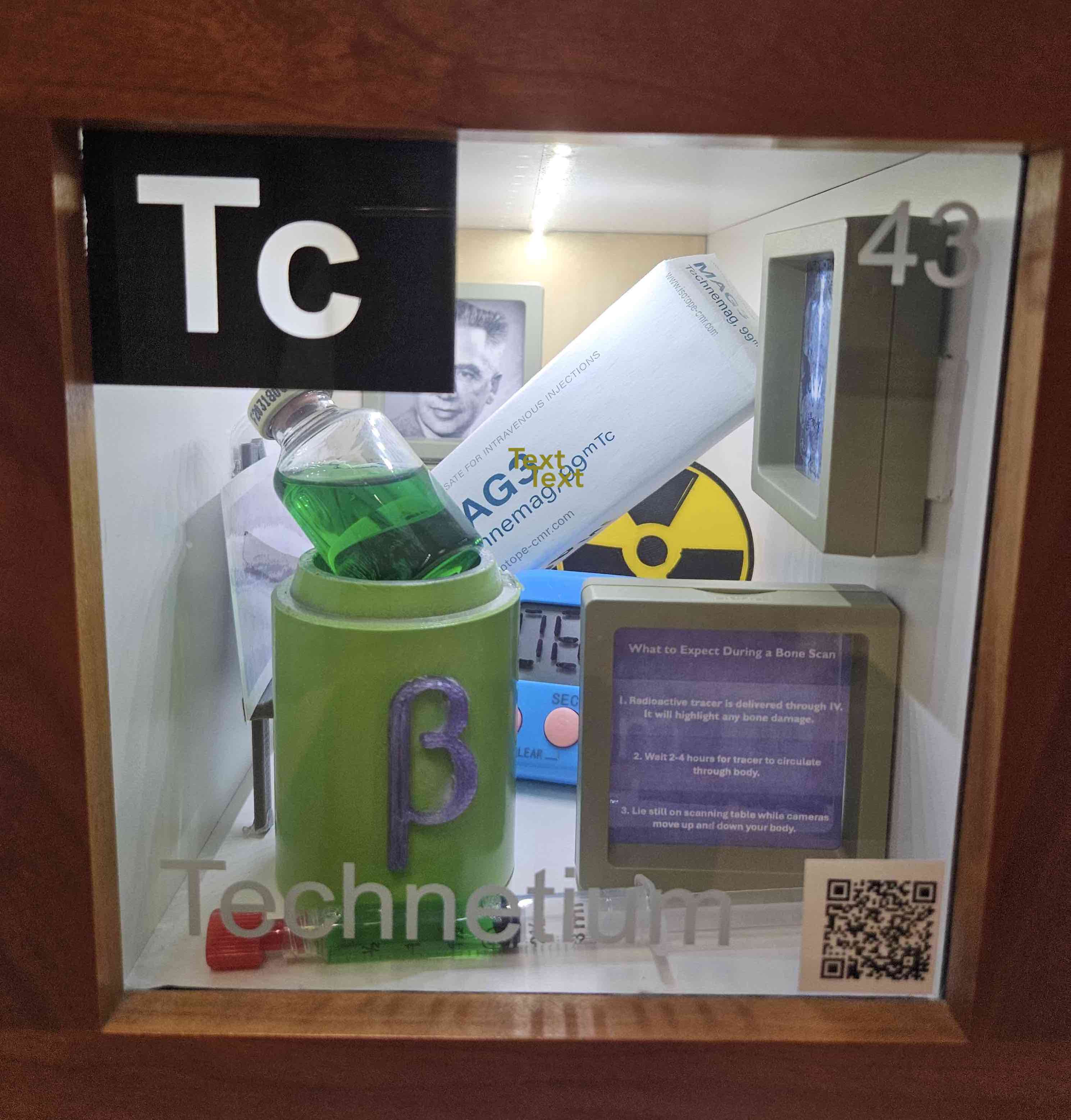Technetium

Contributors: Lily Allen, Katie Witte and Jeanette Marshall. "We chose Tc because we attend Tiffin
Columbian High School (TC for short). Researching the element Technetium is a unique
way to represent our school and a fun learning opportunity."
How is it used?
Technetium was approved for medical use in the United States in June 1990 as a radiopharmaceutical.
“Radiopharmaceuticals are radioactive agents, which may be used to find and treat certain diseases or to study the function of the body's organs” (“Technetium tc 99m medronate (intravenous route)”).
Where can it be found?
Technetium is rare because its isotopes are short-lived. It is a man-made element produced during nuclear reactor operations and is a byproduct of nuclear weapons explosions. Because of this, traces of Technetium can be found in the Earth's crust.
About the Display:
- A picture of the element: This picture shows the physical appearance of the Technetium.
- Pictures of a kit for the preparation of a Technetium 99m oxidronate injection and representation for Mag3 box: Using this kit, a qualified professional can easily prepare a Technetium 99m oxidronate injection. There are many different variations of this injection, each to image a different organ. Inside the kit, there are sterile, non-reactive vials. After its preparation, the injection will last for about 12 hours.
- Vial and syringe containing green liquid and lead protective cover: The green colored liquid is representative of Technetium-99m (Tc-99m) Sulfur Coilloid. This radiopharmaceutical is used in nuclear medicine to visualize organs such as the esophagus, stomach, and lungs, helping doctors diagnose conditions like gastroesophageal reflux and pulmonary aspiration. However, the green liquid in this display is not actual Technetium (Tc-99m) Sulfur Colloid, it is simply green-colored water in a glass vial. While the liquid is only a visual representation, the lead protective container shown is real and is the same type used in the medical field to safely transport radiopharmaceuticals. These display items were generously provided by Joseph Agosti, Radiation Safety Officer at the University of Toledo.
- A scan of Tc in the human body: A visual depiction of what a scan will look like with Technetium 99m added as a tracer.
- Schematic showing what to expect during a bone scan.
- Radioactive warning sign to represent the radioactive nature of Tc.
- Pictures of the cofounders of Tc: Emilio Segrè and Carlo Perrier.


Emilio Segrè Carlo Perrier
- A stopwatch set at 6 hours: When used for medical purposes Tc only remains in the human body for about 6 hours.
- β symbol: This is the symbol for a beta particle. Technetium releases radiation in the form of beta particles.
Fun Facts:
- Technetium is rare because its isotopes are short-lived.
- The longest living isotope of Technetium has a half life of relatively 4 million years.
- Technetium has a melting point of 2157 °C and a boiling point of 4262 °C.
- Technetium is a grey, odorless, radioactive element. It has 43 protons and 2 valence electrons. Abbreviated Tc, technetium is solid at room temperature.
About the Contributors:

Listed in order:
- Katie Witte - Freshman at Tiffin Columbian High School, Honors Physical Science student, Tiffan, OH
- Jeanette Marshall - Chemistry and Physical Science teacher at Tiffin Columbian High School, Tiffin, OH
- Lily Allen - Freshman at Tiffin Columbian High School, Honors Physical Science student, Tiffin OH
They decided that researching the element Technetium for the periodic table would be a unique way to represent their school: Tiffin Columbian High School (TC for short), and a fun learning opportunity.
Works Cited:
- “Kit for the Preparation of Technetium Tc 99m Medronate Injection.” accessdata.fda.gov,
https://www.accessdata.fda.gov/drugsatfda_docs/label/2010/018035s029lbl.pdf. Accessed 23 January 2025.
- “Office of Radiation Protection - Technetium-99 (Tc-99) Fact Sheet.” Washington State Department of Health,
https://doh.wa.gov/sites/default/files/legacy/Documents/Pubs//320-083_tc99_fs.pdf. Accessed 16 January 2025.
- Perrier, Carlo. “Technetium - Element information, properties and uses | Periodic Table.” The Royal Society of Chemistry,
https://www.rsc.org/periodic-table/element/43/technetium. Accessed 23 January 2025.
- “Technetium-99m - StatPearls.” NCBI,
https://www.ncbi.nlm.nih.gov/books/NBK559013/. Accessed 23 January 2025.
- “Technetium tc 99m medronate (intravenous route).” Mayo Clinic , 31 January 2024,
https://www.mayoclinic.org/drugs-supplements/technetium-tc-99m-medronate-intraveno us-route/description/drg-20075278. Accessed 16 January 2025.
Back to the Periodic Table
| |-Onward to the next element!> |
Symbol: Tc
Atomic Number: 43
Atomic Mass: 98 u
Electron Configuration: [Kr] 4d55s2
Year Discovered: 1937
Discovered By: Carlo Perrier and Emilio Segrè


